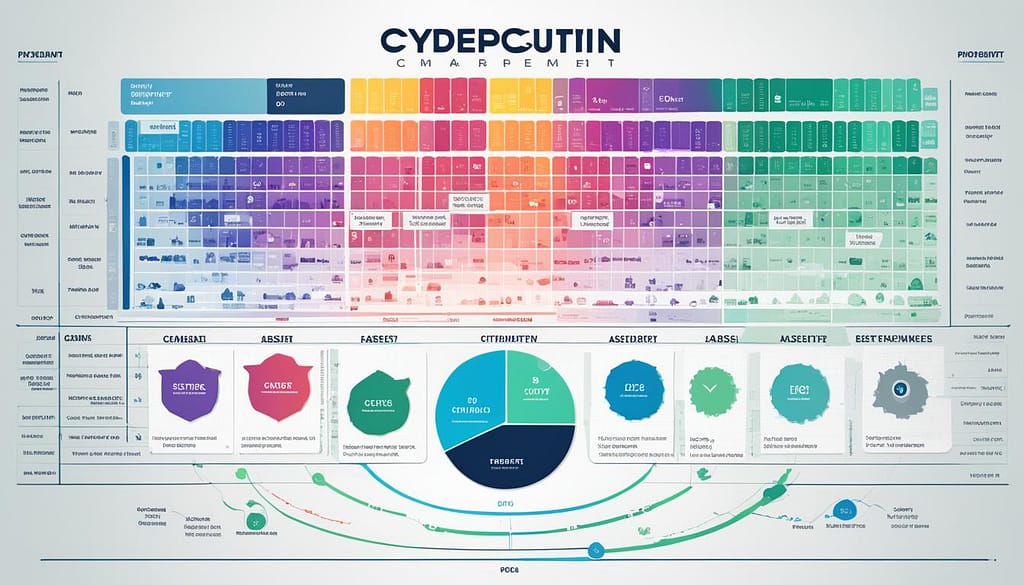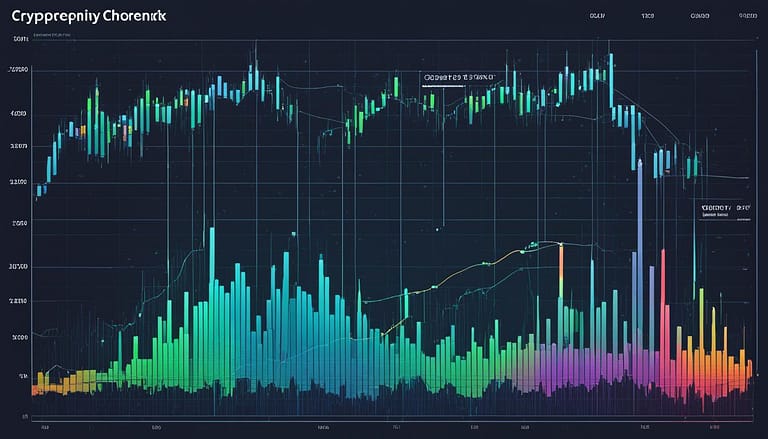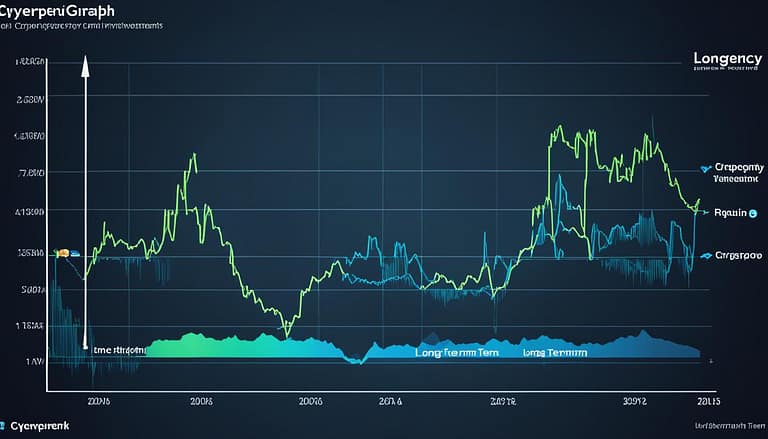Strategies for Crypto Investing During a Bear Market
When faced with the chilling winds of a Crypto Bear Market, Canadian investors are frequently searching for robust strategies to safeguard their portfolios. Crypto Bear Market Strategies become vital tools to navigate these Market Downturns, offering a beacon through the turbulence to the potential Investment Opportunities that arise during these challenging times. It’s a period where the savvy investor turns to seasoned tactics to transform a bear’s growl into a signal to act judiciously.
Understanding the intricacies of market cycles can be as daunting as a brisk walk in the heart of winter. Yet, those who endure can find resilient seeds ready to sprout during eventual market thaws. Regardless of the frosty market environment, opportunities for growth are woven within the very fabric of market downturns, for those equipped with knowledge and strategic insight.
Key Takeaways
- Strategizing is key to navigating a Crypto Bear Market effectively.
- Market Downturns reveal unique opportunities for the cautious investor.
- Investment strategies must be adapted to bear market conditions for potential growth.
- Knowledge of market cycles empowers informed decision-making.
- Endurance and strategic action during downturns can lead to future rewards.
Understanding the Crypto Bear Market Phenomenon
When navigating the turbulent waters of crypto investment, it’s essential to recognize the stark differences between various market cycles and how they influence the valuation of digital assets. As history has shown, understanding these cycles can be the key to strategic positioning within the market.
Defining a Crypto Bear Market
A crypto bear market signals a time of downturn and caution for investors. It is defined by a persistent decline in asset prices, generally accepted as a drop of 20% or more from their peak. A bear market in the crypto realm requires investors to reassess their strategies, often shifting focus from profit-making to preservation of capital.
Comparing Bear and Bull Markets
To fully grasp the concept of a bear market, one must compare it with its counterpart: the bullish phase. Whereas a bear market is beset by pessimism and declining prices, a bull market revels in optimism, increased investor confidence and a general upswing in digital asset values. These two opposing cycles form the rhythm of the investment landscape, each presenting unique challenges and opportunities.
Crypto Bear Market Triggers Through History
The triggers for crypto bear markets often stem from events that shake investor confidence and prompt widespread sell-offs. Major incidents that disturbed the market equilibrium include breaches like the Coincheck hack, regulatory shifts such as China’s tightening of crypto rules, or shockwaves sent by significant institutional failures, for instance, the collapse of Mt. Gox. Each event is a lesson in the fragile nature of market sentiment and its impact on digital asset valuations.
Amid the discussion of market dynamics, the role of historical events in shaping current investment approaches cannot be overlooked. They serve as a reminder of the unpredictable nature of crypto market cycles and necessitate a robust understanding for anyone involved in digital asset investment. The following table presents a comparative glance at notable bear market triggers and their outcomes.
| Event | Date | Immediate Impact | Long-Term Effect |
|---|---|---|---|
| Coincheck Hack | January 2018 | Loss of $534 million worth of NEM tokens | Increased demand for enhanced security protocols |
| Federal Reserve Rate Hikes | 2017-2018 | Investor shift towards less risky assets | Greater scrutiny on investment diversification |
| Silk Road Shutdown | October 2013 | Temporary loss of confidence in cryptocurrencies | Push for regulatory clarity and legitimization of digital assets |
| China’s Crypto Regulations | 2017-Present | Repeated market sell-offs after regulatory announcements | Growing focus on decentralized platforms |
| Mt. Gox Hack | February 2014 | Approximately 850,000 BTC stolen, shaking the market foundation | Calls for industry-wide standards and investor protection measures |
Assessing the Current State of the Crypto Market
The Crypto Bear Market has made its presence undeniably felt in the investment community, ushering in a deep sense of caution among stakeholders. With asset values descending sharply, the drop in Investor Confidence is palpable, leading to a substantial recalibration of market participation. The current Market Outlook remains tethered to developments that may either aggravate the bearish trend or signal the advent of a recovery.
Reflecting on the drastic downturn, seasoned analysts highlight the necessity for investors to adjust expectations and refine investment criteria amidst continued volatility.
A thorough analysis of market trends yields several critical insights:
- FUD (Fear, Uncertainty, and Doubt) has compounded the market’s vulnerability, precipitating steeper declines.
- The retreat of new investors, who have been daunted by the stark market conditions.
- An ongoing examination of market dynamics that may shape future trajectories.
In this context, representing a detailed assessment, the following table juxtaposes key indicators that are influential in gauging market temperament:
| Indicator | Status | Impact on the Market |
|---|---|---|
| Investor Sentiment | Negative | Increased selling pressure |
| Market Liquidity | Reduced | Difficulty in order execution |
| Trading Volume | Declining | Potential for increased volatility |
| Regulatory News | Uncertain | Possibility of swift market reactions |
The data underscore an environment fraught with challenges yet not devoid of opportunities for the astute observer. Moving forward, it is crucial for investors to remain apprised of the shifting currents within the Crypto Bear Market to navigate these tumultuous waters with strategic foresight.
Crypto Bear Market Strategies: Navigating Market Downturns
During tumultuous market downturns, individuals invested in cryptocurrencies must employ robust financial strategies to manage their portfolios effectively. The uncertainty associated with a bear market requires a calculated approach to crypto investing, focusing on methods that can lead to stabilization and growth of one’s assets.
One of the most prudent strategies is practicing dollar-cost averaging (DCA). This technique enables investors to purchase cryptocurrency at regular intervals, with a fixed amount of fiat currency, thereby averaging their entry price over time and reducing the impact of volatility. It’s an approach common in asset management guiding investors to stay invested and avoid trying to time the market, which is particularly challenging during bear phases.
- Focus on Long-Term Objectives: Investors are advised to maintain a long-term outlook and not let short-term market fluctuations deter them from their financial strategy.
- Resist Market Noise: In times of market stress, avoiding knee-jerk reactions to rumors or unverified claims from resources such as Crypto Twitter is crucial. Investors should stick to credible sources of information.
- Diversify Wisely: Allocating investments across a variety of assets can mitigate risk. However, the priority should be given to in-depth research before diversification, especially in crypto markets.
The contradictory nature of a bear market may also present unforeseen buying opportunities. Experienced investors recognize that maintaining composure and strategic acumen is essential in navigating these rough waters successfully.
“A key to successful crypto investing is to avoid making impulsive decisions based on the day-to-day market. Instead, focus on the overall direction of your financial strategy,” notes a seasoned asset management professional.
In consolidating one’s investment approach during a bear market downturn, it is essential to evaluate and potentially adjust one’s financial portfolio regularly. By conducting regular assessments, it is possible to ensure that your investment decisions remain aligned with your broader financial goals and the current market environment.
In summary, navigating a crypto bear market effectively requires meticulous planning and adherence to time-tested investment principles. It’s not the movements of the market that define success, but how one reacts to them, particularly when adopting a strategy built upon solid foundations of financial strategy and asset management.
Incorporating Dollar-Cost Averaging into Your Investment Plan
Within the dynamic realm of cryptocurrencies, investors are often seeking methodologies to stabilize their Crypto Portfolio against the unpredictable tides of Market Volatility. As artists meticulously apply stroke after stroke to create a masterpiece, investors equally pursue precision through their Investment Strategy. Thus emerges the technique known as Dollar-Cost Averaging (DCA), especially adept amidst the financial tempests.
The Mechanics of Dollar-Cost Averaging
The foundational principle of DCA lies in its systematic investment approach. By allocating a predetermined amount of capital into cryptocurrencies at regular intervals, it eliminates the penchant for timing the market, which often results in costly missteps. As markets ebb and flow, DCA’s steadfast regimen acts as an anchor, affording investors the boon of purchasing more cryptocurrency units when prices are low and fewer units when the market sees an uptick.
Real-World Application of DCA During Downturns
Amidst fiscal downturns, apprehension and skepticism frequently besiege the crypto market, leading investors to hunt for tangible applications of DCA. When asset values descend, those embracing DCA stand to fortify their portfolios by acquiring a greater quantity of assets — a manoeuvre potentially culminating in lucrative long-term yields post-recovery.
| Investment Period | Asset Price | Units Acquired with DCA | Total Investment Cost |
|---|---|---|---|
| January | $100 | 1 | $100 |
| February | $80 | 1.25 | $100 |
| March | $60 | 1.67 | $100 |
| April | $50 | 2 | $100 |
This table elucidates the efficacy of DCA; as the investment remains unaltered, the purchase power amplifies, granting more assets with the same investment. When dawn arrives after the enduring night of a bear market, those who upheld the tenets of DCA bear witness to the true potential of their augmented portfolios, having turned market adversity into a testament of their foresight and tenacity. Cryptocurrency investment is not without its challenges, yet through strategic approaches like DCA, the path to stability becomes illuminated against the fluctuations of a mercurial market.
Long-Term Investment Perspectives in Crypto
In the realm of cryptocurrencies, an emphasis on long-term investment horizons holds significant importance. Especially during tumultuous times, the ability to look beyond immediate crypto valuations and assess the enduring asset performance could distinguish the prudent investor from the crowd. It is within this context that we delve into the strategic perspectives essential for long-term success in the dynamic crypto market.
Maintaining Focus on Long-Term Objectives
One’s journey through the crypto ecosystem ought to be navigated with clear objectives that align with personal financial goals, stretching beyond the current market climate. Despite the bear market’s chilling effects on the short-term outlook, investors are reminded to revisit—and remain steadfast to—their foundational investment rationale. This disciplined approach serves as an anchor amidst market turbulence, guiding the investor through the ebb and flow of price movements.
Assessing Real Value Beyond Price Fluctuations
Value assessment in cryptocurrency investing should transcend the often mercurial nature of market prices. Investors are encouraged to conduct comprehensive due diligence and contemplate the intrinsic worth of digital assets. One must factor in technology robustness, use-case potential, and innovative capabilities that signal possible resurgence and rewarding investment horizons when market sentiment ultimately shifts.
Through both bull and bear markets, we learn that short-term vicissitudes need not define the enduring quality or the eventual success of an investment. It is with a forward-looking gaze, accompanied by informed evaluation of crypto valuations and asset performance, that investors may harness the potential for substantial growth over time.
Diversification of Assets Amidst Investment Opportunities
As financial markets endure the tremors of volatility, the prudent allocation of capital takes precedence. Asset allocation, crucial in sculpting robust portfolios, becomes an investor’s bulwark against the unpredictable tides of the markets. In crafting such a fortress, crypto diversification and risk mitigation stand as pivotal principles, ensuring the resilience of an investor’s holdings.
Balancing a Portfolio with Varied Crypto Assets
The art of asset distribution is, at its core, a quest for balance, where the composition of investments spans across cryptocurrencies, equities, commodities and more. The goal is to achieve an efficient blend that resonates with the investor’s appetite for risk and long-term objectives. Crypto diversification, for instance, extends beyond merely accumulating different digital currencies; it involves strategic positioning across sectors, blockchain technologies, and market capitalizations.
Risks Associated with High-Reward Projects
The allure of high-return projects often cajoles investors into veering off the path of due diligence. Here, risk mitigation plays a critical role, prompting an evaluation that is as thorough as it is unbiased. The spectrum of risks, ranging from liquidity to regulatory, must be scrutinized, understood, and weighed against the potential rewards.
| Asset Class | Characteristics | Role in Diversification | Risk Level |
|---|---|---|---|
| Cryptocurrencies | High volatility, Intangible assets, Decentralized nature | Innovative growth potential, Non-correlated asset class | High |
| Stocks | Ownership in companies, Dividend potential | Growth through market appreciation, Dividends as income | Medium to High |
| Bonds | Fixed income securities, Interest payments | Stable income, Lower volatility | Low to Medium |
| Commodities | Real assets, Price movement based on supply and demand | Hedge against inflation, Diversification from financial assets | Medium |
| Cash and Cash Equivalents | Liquidity, Stability, Short-term | Capital preservation, Accessibility for opportunities | Low |
In crafting a diversified portfolio, one must venture beyond surface-level attributes and delve into the intrinsic qualities each asset class offers. This approach not only positions an investor to capture growth across different market conditions but also provides a safety net when particular sectors face downturns.
Crypto Portfolio Rebalancing During a Market Downturn
In times of a market downturn, maintaining financial health requires a strategic approach to portfolio management. One crucial strategy is crypto rebalancing, an integral part of investment management geared towards aligning an investor’s portfolio with their risk appetite and strategic goals. An effectively rebalanced portfolio navigates through volatilities, optimally reallocating resources between underperforming and potentially lucrative assets.
Considering the unpredictable swings in the crypto landscape, a portfolio may quickly diverge from its target allocations. This discrepancy necessitates regular review and adjustment to mitigate risk and capture growth, marking the essence of proactive rebalancing. Let’s delve into the elements of rebalancing and its potential impact on preserving and enhancing investor portfolios during turbulent market conditions.
| Investment Element | Pre-Rebalance State | Rebalanced State | Strategic Benefit |
|---|---|---|---|
| Asset Allocation | Skewed due to market volatility | Realigned with risk tolerance and goals | Reduces exposure to undesired risks |
| Investment Mix | Concentrated in underperforming assets | Diversified across more resilient assets | Opportunity to capitalize on recovery |
| Risk Management | Disproportionate to original investment strategy | Adjusted to optimal risk-return profile | Ensures portfolio can withstand fluctuations |
| Growth Potential | Limited by market downturn impact | Expanded by targeting assets with rebound potential | Aligns with long-term wealth creation objectives |
Rebalancing isn’t about timing the market, which is most often a fool’s errand, especially in the mercurial realm of cryptocurrencies. Rather, it’s about restoring the balance that initially defined the portfolio’s purpose. This involves tactically paring down on investments that no longer serve the intended strategy or exhibit undesirable risk and ramping up on those with a more favorable outlook.
Portfolio rebalancing is akin to navigating a vessel through a tempest; one must continually adjust the sails to counter the blustering winds and keep the ship on course towards its destination. – Traditional Financial Wisdom
- Review the portfolio against the backdrop of current market conditions and strategic goals
- Diagnose assets that deviate significantly from the desired risk/return profile
- Implement changes designed to fortify financial health and asset resilience
- Monitor post-rebalancing performance and adjust as needed in response to market movements
Ultimately, a disciplined approach to crypto rebalancing during market downturns is not just about preservation but also about positioning for future growth. Investors embracing this method stand a better chance of navigating through the churning waters of crypto volatility and onto steadier tides.
Scrutinizing the Crypto Fundamentals: Looking Beyond Hype
Amidst the turbulence of a bear market, the merits of crypto assets are put to the test. Investors and analysts turn their focus on Investment Analysis and Project Evaluation to discern the resilient from the fleeting. Crafting a judicious eye towards the foundational elements of blockchain initiatives is more crucial than ever in upholding a strategic advantage.
Enlightened investors understand that amidst market speculation, true value is unveiled by piercing through the hype to examine the bones of a crypto asset. Here’s where a rigorous analysis becomes an investor’s most potent tool, especially at times when market sentiments are grim, and survival hinges on intrinsic worth rather than exterior buzz.
Evaluating Project Whitepapers and Roadmaps
The discerning process of Project Evaluation is deeply rooted in the dissection of whitepapers and roadmaps – documents that spell out the essence of crypto ventures. Analytical perusal of these documents can illuminate an investment’s prospects, delineating a blueprint for future growth and technical feasibility.
Diligently examining the technical specifications, use cases, developer credentials, and strategic milestones can separate the wheat from the chaff. A project that articulates clear objectives with feasible delivery timelines stands as a beacon of hope in the fog of general marketplace confusion and fear.
Understanding Tokenomics and Community Strength
The prosperity of Crypto Assets is equally dependent on robust tokenomics and the fervour of its community. The architecture of a token’s economy lays the foundation for how it functions within its ecosystem, influences user behaviour, and determines scarcity and demand – paramount factors for long-term viability.
Yet beyond economics lies the palpable pulse of any project: its community. The enthusiasm and engagement of its user base are often indicative of a project’s endurance. A thriving community not only supports transactions but also drives development and fosters innovation through collective intellect – a crucial asset during the testing times of a bear market.
In sum, truly holistic Investment Analysis eschews short-term flutters and embraces a comprehensive audit of a project’s bedrock. And it is this meticulous approach to evaluating Crypto Assets that could equip investors with the discernment essential to navigate the whimsical waters of the cryptocurrency markets.
Secure and Strategic Management of Crypto Investments
As the landscape of digital currency becomes ever more intricate, the need for robust Crypto Security measures and strategic Investment Risks management is more pronounced than ever. Investors are urged to undertake meticulous Strategic Planning to shield their crypto holdings from the unpredictable nature of the market, aligning with best practices for a fortified investment approach.
Utilizing Secure Wallets and Exchanges
Safeguarding crypto assets necessitates the use of highly secure wallets and exchanges. Esteemed platforms such as Coinbase and Ledger offer sophisticated protection mechanisms, catering to the safety-conscious investor. The utilization of cold storage wallets or multisig wallets can significantly dampen the threat of unauthorized access, enhancing the resilience of your crypto portfolio.
Implementing Risk Management Techniques
Effective risk management is a decisive factor in navigating the volatile domain of cryptocurrencies. Proactive techniques, such as stop-loss orders, allow investors to set limits on potential losses. Those with more experience may venture into the complexities of derivatives for hedging but must possess a profound comprehension of these instruments to employ them beneficially.
| Technique | Description | Benefit |
|---|---|---|
| Stop-Loss Orders | Automated sell-off when asset value drops to a predefined level | Limits financial loss and mitigates emotional decision-making |
| Cold Storage Wallets | Offline storage of cryptocurrencies | Reduces the risk of hack and unauthorized online access |
| Derivatives | Financial instruments derived from an underlying asset | Provides a hedging strategy to counter adverse price movements |
| Multisig Wallets | Requires multiple signatures to authorize a crypto transaction | Enhances security through collaborative control |
Conclusion
As we dissect the intricacies of maneuvering through the turbulence of a crypto bear market, it’s clear that the deployment of robust cryptocurrency strategies can effectively cushion and potentially elevate one’s financial stance amidst widespread trepidation. The implementation of dollar-cost averaging as a systematic purchasing method, supported by a comprehensive strategy of diversification, paves a pathway for enhanced financial resilience. Furthermore, the thoughtful rebalancing of one’s crypto portfolio in response to shifting market dynamics stands as a testament to proactive asset management.
Upholding a long-term investment view serves as an antidote to the reactionary impulses bred in the throes of market downturns. This perspective, woven with the savoir-faire to appraise the intrinsic value of digital currencies, separates the steadfast investor from the crowd. Indeed, mastering the market analysis to navigate these cryptic waters is as much an art as it is a science, requiring a meld of data-driven insights and unwavering resolve.
In summation, while the path through a crypto bear market is fraught with challenges, an armor of well-reasoned tactics and disciplined execution fortifies investors against the fickle winds of fortune. Nevertheless, we must acknowledge the inherent uncertainties that festoon the investment landscape, for they dictate a necessary readiness to endure the caprices of a market in constant flux. As stewards of our own financial journeys, this readiness—coupled with an educated approach—provides a beacon through the tempest, guiding toward eventual emerge triumphant.










